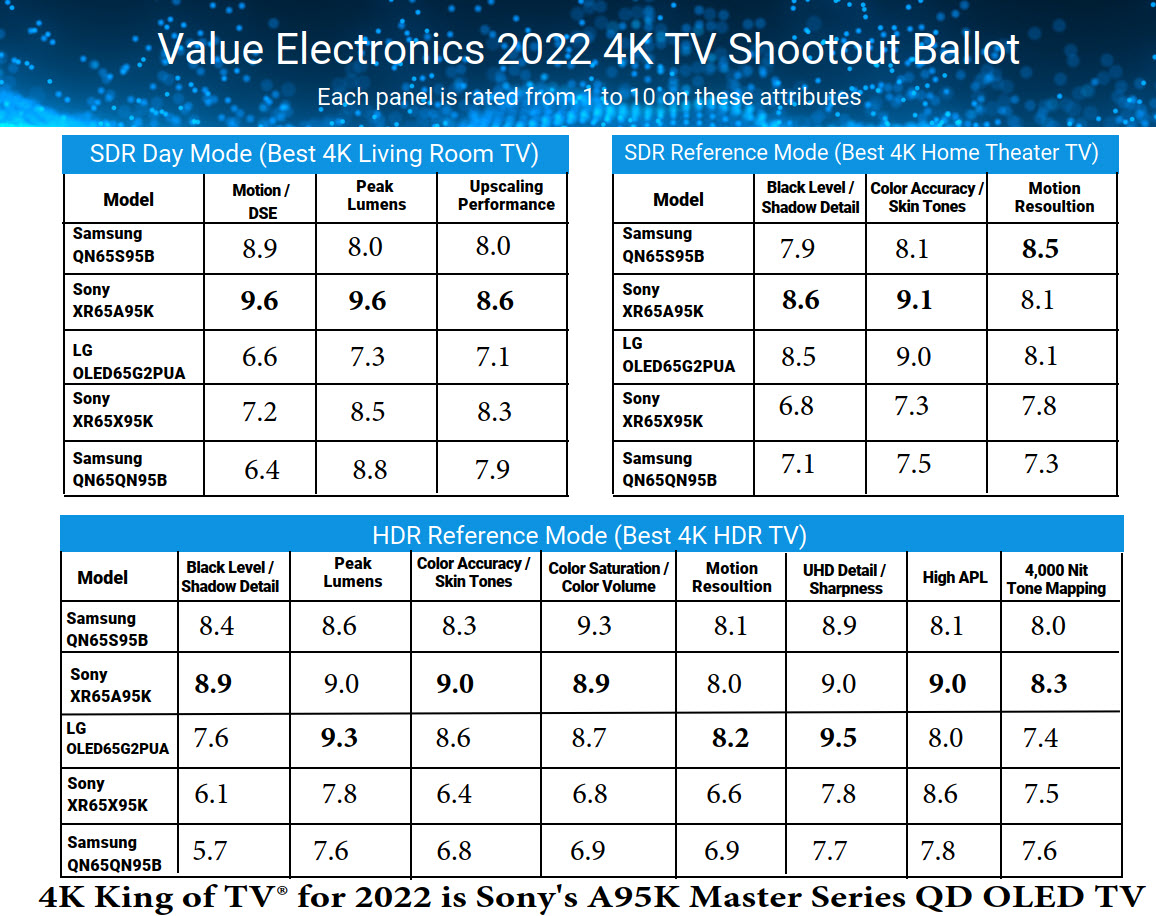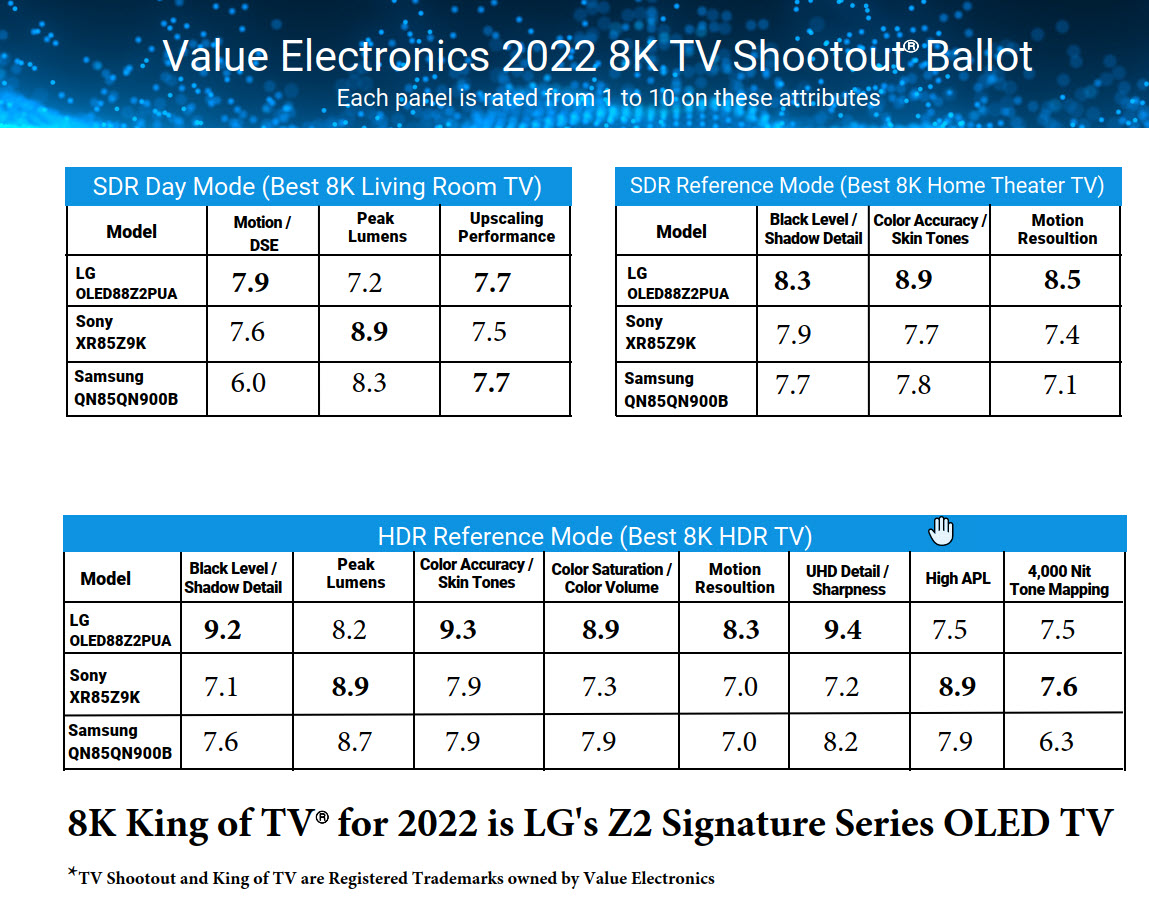There was much excitement leading up the 2022 VE Shoot-Out because QD-OLED sets would be competing for the first time, but surprises would soon appear. Everyone expected OLEDs to do well. As Robert Zohn (Value Electronics CEO and founder of the Shoot-Out) reminded the judges, calibrators, members of the press, and guests, a self-emissive display had won the “King of TV” award in every year but one.

The Shoot-out was in two parts: 4K sets on July 30, 2022; and 8K sets on July 31; both at the the Company Building, 335 Madison Avenue in New York. The balcony on which afternoon drinks were served overlooks Grand Central Terminal.
All sets were calibrated to industry standards and a signal distribution system delivered identical signals to each set simultaneously.
The Judges
John Reformato (Engineer and ISF III Calibrator) was head of the calibration team and also a judge. The other judges were David Mackenzie (Compressionist, Fidelity in Motion), David Medina (Manager, Production Technical Operations, Warner Brothers Discovery HBO), DeWayne Davis (Calibrator and Display Consultant, Audio Video Fidelity), Ed Johnson (Video Calibrator and Engineer), Giles Sherwood (Director of Post Production, Criterion), Ilya Akitoshi (Colorist and Digital Imaging Technician), Jason Dustal (ISF Level lll Instructor and Head of Training, Murideo), Jeffrey Hagerman (Post Production Digital Imaging Senior Technician), and Kenneth Almestica (Senior Technical Director, Viacom). I like to think I’m pretty good at this stuff, but listening to these guys was humbling.
You Need a Reference
The reference monitor used for the evaluation was the Sony 31-inch BVM-HX 310 mastering monitor that uses dual-cell LCD technology and sells for $35,000. For all applicable tests we were instructed to judge the sets by how closely their images matched that on the reference monitor. After the evaluations were in progress, several judges commented that it would be impossible to get meaningful results with referring to the reference monitor.
The testing sequence consisted of a variety of visual tests based on test patterns and carefully selected cinema and video content. The viewing and judging of the 4K sets took an entire day; the judging for the 8K sets took much of the second day. Now, let’s get to the viewing and judging.
The contenders in the 4K category were the Samsung S95B QD-OLED, the Sony A95K QD-OLED, the LG G2 WOLED, the Sony X95K QLED MiniLED, and the Samsung QN95B QLED MiniLED, all with 65-inch screens. The sets appear left to right in the photographs.
The Tests
I won’t second-guess the judges (although I did in my notes), but I should describe some of the tests to explain what they were looking for. The SDR (standard dynamic range) tests are based on input signals mastered to the BT.709 color gamut and a maximum input luminance of 100 nits, a standard that goes back to the days of CRT TV. It may surprise some readers that a tremendous amount of content is still mastered to BT.7069 including the evening news. (There’s no reason to waste bandwidth on a talking head.)
For the SDR day mode, the curtains were opened and the room was fairly bright. One of the things we looked for was DSE — the dirty screen effect — at 50% gray and 100% white. The Samsung LCD had a noticeable lack of uniformity across the entire screen, and the LG G2 had significant non-uniformity along the left side of the screen. The effect can be seen in the first column of the SDR Day Mode table. The judges were reminded that the ABC (automatic brightness control) on the OLED sets can start reducing luminance, particularly with a 100% white pattern, which can affect white point as well as luminance.
We also looked at SDR upscaling and deinterlacing performing with a 480i input signal. “The program material (a hockey game) was not sharp on any of the sets but was deemed “watchable.” Things looked considerable better with 1080i input, and the judges felt the Sony A95K QD-OLED was best at this overall.
SDR Reference Mode
In SDR reference mode (in a darkened room) we looked at a test pattern to assess the luminance level at which a visible signal emerges from black. The two QD-OLEDs were first and third here, with the LG G2 WOLED set second.
Color accuracy/skin tone was judged by comparing the color of people’s faces with appearance on the monitor. The Sony A95K and the LG G2 were very close here, with the Samsung S95B a bit behind. Both of the LCDs were well off the pace.
HDR Reference Mode
In HDR reference mode — let’s call it movie-watching mode — clips from “Jaws” were used to assess color fidelity. The Sony A95K colors were closest to the monitor, and they were very close. The LG G2 was close behind, and the Samsung S95B not far behind that. The Samsung QN95B had a distinct yellow tinge.
A travelling text pattern (ticker tape) was used to test motion resolution. The three OLED sets were within a hair of each other, with the LCDs substantially worse.
A high-APL (average picture level) image had blown-out highlights on the QN95B and the G2. The Sony A95K did very well here with the X95K LCD a close second.
Tone Mapping Tested
The 4000-nit tone-mapping test is an interesting one. A signal mastered at 4000 nits peak is presented to the sets, and the tone-mapping of each set has to adjust all of the levels to fall within each set’s peak luminance. Ideally, all of the original luminance levels will still be distinct (but that’s impossible) and the mapping of each primary will track exactly so white (for instance) will still be white at all brightness levels.
Since the peak luminance of OLEDs is generally less than LCDs the levels have to be compressed more severely and you would expect them to show the worst color distortions. That was often true in the past, but this time both QD-OLEDs (perhaps because of their higher peak luminance than conventional OLEDs) did the best here. The other three sets were closely clustered a modest distance behind.
The ratings in the individual categories are shown in the accompanying tables. The overall results for the individual modes follow. For SDR day mode, the Sony A95K was first with a score of 9.3; the Samsung S95B was second with 8.3; and the LG G2 was third with 6.7.
For SDR reference mode, the Sony A95K was again first with 8.6; the LG G2 was barely behind at 8.5, and the Samsung S95B was also not far behind at 8.2. For HDR reference mode the Sony A95K was again first with 8.8 but the S95B and the G2 were tied for second at 8.4.
 The 2022 4K TV Shoot-Out ballot and detailed scores. (Graphic: Value Electronics)
The 2022 4K TV Shoot-Out ballot and detailed scores. (Graphic: Value Electronics)
Overall, the A95K was first with 8.9 points, winning the title “King of 4K TVs.” So the two QD-OLEDs came out first, which was perhaps not a surprise. But the LG G2 WOLED was close behind and won several categories outright. That was the surprise.
 Robert Zohn (right) presents the 2022 King of 4K TV Award to Sony’s Rob Brennan (center) and Pablo Espinosa. (Photo: Mark Jessamy Photography)
Robert Zohn (right) presents the 2022 King of 4K TV Award to Sony’s Rob Brennan (center) and Pablo Espinosa. (Photo: Mark Jessamy Photography)
Said Robert Zohn:
“I’ve never seen leading TVs come out so close. This is the biggest upgrade in picture quality I’ve seen in 10 years.”
Since the leading sets were so close, I couldn’t help but think of my time in manufacturing engineering and wonder whether unit-to-unit variability could change the results. DeWayne Davis, who has compared multiple units of various models, came to my rescue:
“Sony and LG have best unit-to-unit consistency. Samsung is much worse.”
John Reformato overheard and added, “They’ve stepped up their QC considerably, especially over the last couple of years.”
Robert Zohn said that when the sets arrive back at Value Electronics, they would be returned to their out-of-the box settings and would be compared again. For the results of this “out-of-the-box shoot-out,” check https://valueelectronics.com/tv-shoot-out-evaluation/.(It hadn’t yet been posted when we went to press – ed.)
Pricing and Value
Price was not factored in the judging but it might affect your personal buying decision, so here are MSRPs. The Samsung S95B QD-OLED, $2799; Sony A95K, $3999; LG G2, $2999; Sony X95K, $2499; and Samsung QN95B, $3299. All of the OLEDs are very fine TV sets, but is the A95K worth $1200 more than the S95B? I’ll leave it to you to decide for yourself (but you weren’t in the room with me, were you?)
8K
On the following day we viewed three 8K TV sets from 85 to 88 inches. They were the LG OLED 88Z2PUA, the Sony XR85Z9K, and the Samsung QN85QN900B. There are not yet any QD-OLED TVs in this size range.
In general, the testing was similar to that of the 4K sets except that native 8K program material was used where appropriate. For shadow detail, the judges rated the LG OLED substantially better than the two LCD sets.
On high-APL (1000-nit peak) content the Sony Z9K was judged substantially superior to the other two sets. I thought the Sony exhibited a light color shift toward red, but the experts apparently saw other things that outweighed that.
For color accuracy/skin tone, the OLED was reckoned to be substantially superior. The two LCDs weren’t horrible, but you had to be careful to view them at small viewing angles.
 Judging 8K TV Sets is a serious business. (Photo: Mark Jessamy Photography)
Judging 8K TV Sets is a serious business. (Photo: Mark Jessamy Photography)
No Sharpness Differences
For UHD detail/sharpness using 8K native program material, it was impossible to find significant differences. It was decided since it was 8K material and 8K sets, each pixel was being driven as intended with no scaling to create difference is detail. “So what’s the point [of this test]?” one judge asked? We did find the center of focus of the original material and determined that high contrast gives the impression of more detail, which is not a new discovery.
The OLED did the worst on the peak lumen test but was surprisingly close to the two LCDs. For 4000-nit tone mapping, the OLED and the Sony Z9X LCD were in a virtual tie, with the QN900B far behind. I saw considerable color non-linearity with the Sony, but the experts didn’t seem to mind.
In SDR Day Mode, all of the sets did reasonably well in upscaling and deinterlacing from 1080i, and they were all very close to each other. In SDR Reference Mode, the LG OLED had the best color accuracy by a significant margin. Also in SDR Reference Mode, the OLED had substantially better motion resolution.
Now for the results. Sony Z9 for SDR Day Mode; LG Z2 for SDR Reference Mode; and the LG Z2 for HDR Reference mode. The overall score was 8.2 for the LG Z2, making it the 2022 8K King of TV Award Winner; 7.8 for the Sony Z9K; and 7.5 for the Samsung QN99B. Yes, the OLED wins, but these scores are very close.
 The 2022 8K TV Shoot-Out ballot and detailed scores. (Graphic: Value Electronics)
The 2022 8K TV Shoot-Out ballot and detailed scores. (Graphic: Value Electronics)
I’ll leave you with the comments of the experts.
“This is the biggest upgrade year I’ve ever seen since the advent of OLED.” said Robert Zohn.
“All the displays are really close,” said Ed Johnson.
“[These are] the most accurate displays I’ve seen in 9 years of participating in the Shoot-Out,” said DeWayne Davis.
One more comment from me: This was an exciting and informative shoot-out. (KW)
Ken Werner is Philosopher Emeritus at Nutmeg Consultants.

